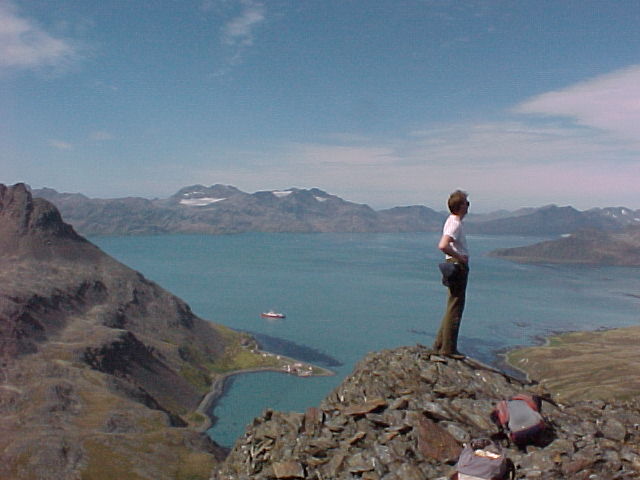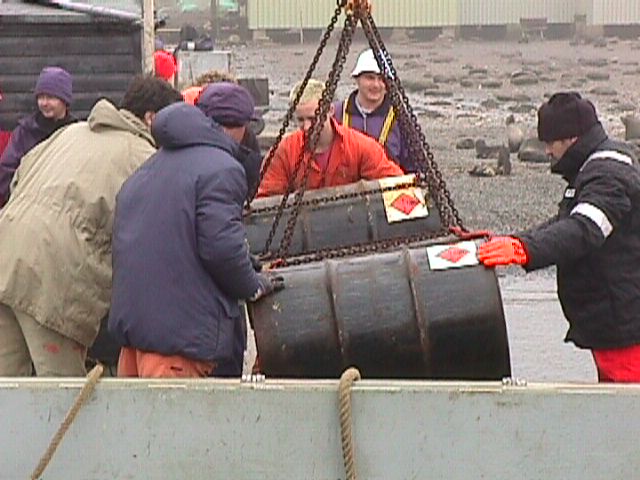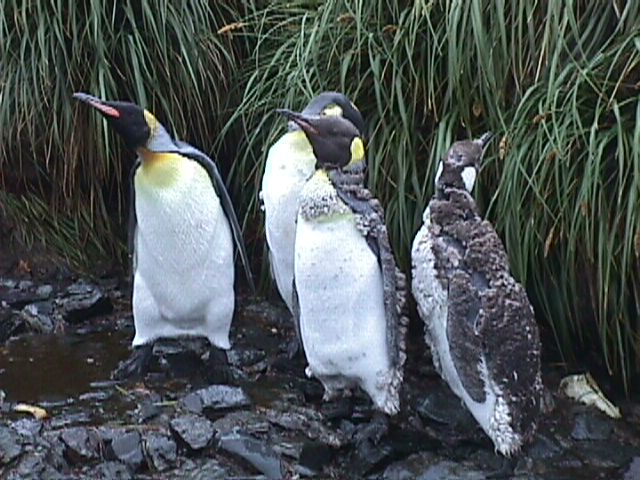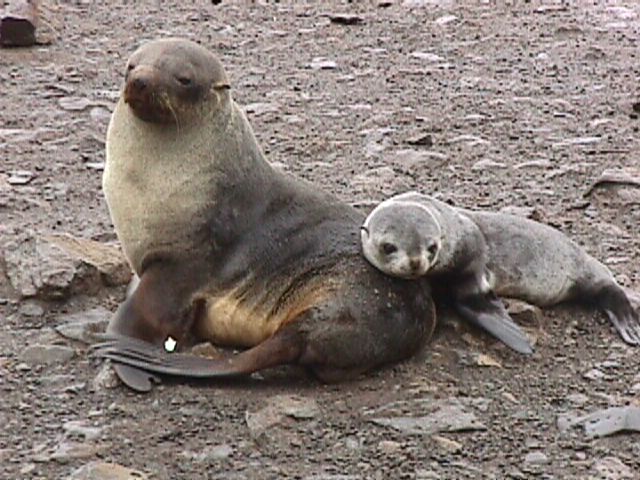| Date | Sunday 28th February 1999 |
| Time | 1200 (UTC-3) |
| Position | Latitude 54°03' South
Longitude 037°07' West Prince Olav Harbour, South Georgia |
| Next destination | Stanley, Falkland Islands |
| ETA | 4th March 1999 |
| Total distance | 19650.8 Nautical Miles
(Since departing Grimsby on 17th October 1998) |
| Current weather | Overcast |
| Wind | Light & variable |
| Sea state | n/a |
| Air temperature | 5.5°C |
| Sea temperature | 4.0°C |
Ship's
track - Updated every six hours from the weather observations sent
to Bracknell weather centre - direct from BAS
homepage.
Summary
Following the ships departure from Signy last Sunday afternoon, good progress was made to Bird Island although the weather on Monday was none too pleasant with heavy seas. It was thought that this would delay our arrival time but with a change in the wind direction we had following seas and were making 13 knots (on one engine), a very impressive speed for the Bransfield.
Tuesday 23rd and we were approaching Bird Island in thick fog. Then, with about one mile to go before the anchorage the fog suddenly started to lift and Bird Island was seen, in sunshine, with South Georgia and some of its amazing peaks also coming into view. This was to be a memorable arrival. Whilst the ship was anchoring the views of the islands continued to be spectacular, with a band of mist around the island at about 20m, giving the whole place a mystical look. Tula was prepared and the intention was to start the cargo movements after lunch. The rain started after lunch! To anyone who has been to Bird Island this came as no surprise and it was to remain with us for the next 36 hours as we discharged the cargo. On the Tuesday afternoon all the remaining fuel (in 205ltr drums) was put ashore along with one load of general cargo. Three of the base members came out to join the Bransfield as they had served their time at the base. Whilst cargo work was underway, the remaining wintering team came out one at a time to the ship to have a final dental checkup with Wendy Scott.
Wednesday 24th and no great change in the weather. It was hoped that the remaining cargo would be put ashore and so Tula left after breakfast with some fifteen personnel on board to help move the cargo up the small jetty to the base. With bases such as Bird Island and Signy there is no room for vehicles to be put ashore to help move all the stores and so manpower is the only option. At least at this time of the year the breeding season is over and the walkways are accessible (with just the odd Fur Seal pup chasing you) and so it is not as difficult as in December when the male seals are defending their mating territory. The days work continued at a good pace and the final run of the cargo tender was at about 1530. It was just then that the weather started to change rapidly and so the last load of cargo was discharged and all personnel not remaining at the base were loaded back onto Tula for a somewhat bumpy ride back to the ship. Once Tula was safely on board and the hatches had been secured the anchor was weighed and we proceeded to sea to ride out the bad weather. That, as is so often the case, was a very speedy farewell to the base personnel and the Bransfield will not now return until next November.
Thursday 25th was a glorious day with a clear sky but strong winds and so the Bransfield remained at sea, with the crew tidying up the holds and making sure that everything was fully secured for the crossing to the Falkland Islands. The whole day was spent some fifteen miles off of South Georgia giving further spectacular views of the snow capped mountains bathed in sunlight.
On Friday 26th we had hoped to go into Cumberland Bay and run boats
to the old whaling station at Grytviken but as we entered the bay the wind
picked up to thirty knots and it was decided not to remain but to go back
out to sea and wait for the weather to improve. Over night the wind eased
and so on Saturday the Bransfield once again entered Cumberland Bay and
the two Starboard lifeboats were launched to run people ashore. The weather
was excellent throughout the day and a number of people managed to climb
Mount Hodges (at the back of the whaling station) and also find a lovely
lake at a height of some 1200 feet - and promptly went for a swim. I understand
that the water was at about 9°c but felt far colder. As the lake was
sheltered from any wind and the sun was very warm and they soon dried off
before returning to the whaling station. The last boat from the whaling
station returned at about 1800 and the Bransfield remained at anchor over
night, leaving Cumberland Bay at about 0600 on the Sunday morning and heading
for Prince Olav Harbour - the site of another whaling station where it
is hoped to stay for the day before setting course for Stanley.
A Brief Potted History of South Georgia - by Mike
Gloistein
South Georgia lies at approximately 54° South and is about
170 km long and ranges in width between 2 and 30 km. The island is spectacular
in that it consists of a large number of snow-capped mountains and has
been described as 'the Alps in mid-ocean' and is in fact the summit of
a partly drowned mountain range. There are two principal mountain ranges,
the Allardyce and Salvesen. The highest peak is that of Mount Paget at
2934 m and there are twelve further peaks of more than 2000 m.
South Georgia was probably discovered by Antoine de la Roché who sighted it in 1675 whilst on passage from South America to France. The next recorded sighting was in 1756 by Gregorio Jerez on board the León. It was in 1775 that Captain James Cook arrived and on 14th January one of his midshipmen, Thomas Willis, saw land which was eventually named after him (The Willis Islands at the western end of South Georgia) and named the land in honour of His Majesty King George as Isle of Georgia. He went on to name Bird Island, due to its large flocks of birds. As part of his report on the island, Captain Cook made mention of the large numbers of elephant and fur seals and this soon came to the attention of the sealing industry and so started what was to become a somewhat bloody period in the history of South Georgia. Due to the very secretive nature of sealers, many records of the earliest activities are not known, however there are some references that date back to 1786. One vessel, the Aspasia, collected some 57 000 fur seal skins in 1800/01 and whilst this was a large number for a single ship it does give some idea of the slaughter that took place on the island. Sealing would continue, in several waves, for the next 100 years and in 1881 there were regulations put into place to control and protect the seals by giving a closed season between 1st October and 1st April.
The first whaling station was established in King Edward Cove in 1904
and between then and 1965 South Georgia was one of the most important places
in the world for the whaling industry. There were whaling stations in seven
harbours on the island and during the period some thirteen floating factories
were also used. In 1965 the whaling stations were abandoned and whilst
at Grytviken a caretaker was employed until 1971, the stations were never
reopened and have now become derelict reminders to the past. During the
period 1904 to 1965 a total of 175 200 whales were taken at South Georgia
compared with 1 432 862 recorded as being taken from Antarctica between
1904 and 1978.
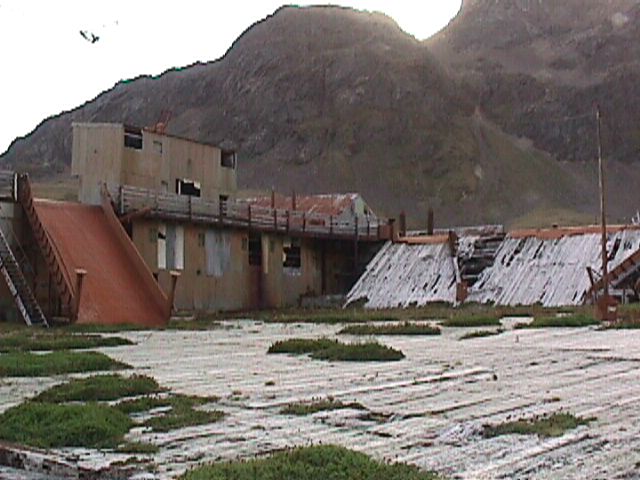
Bird Island was first visited for scientific purposes in 1958 when a two man team was active on the island. The first overwintering party was in 1963 when a three man team remained to study data on the breeding cycle of the wandering albatross and stayed until April 1964. Since the 1972/3 season Bird Island had been manned as a summer base but in 1981/2 a new building was erected with improved facilities and accommodation for eight people and the base was permanently manned from 1983.
Further Reading
Antarctic Oasis, Under the Spell of South Georgia, by Tim and Pauline Carr. Published by W.W.Thornton & Co Ltd. ISBN 0-393-04605-2 This book offers some of the best photographs of South Georgia, taken at all times of the year, and has an excellent narrative of the Carr's stay on the island for the past six years on their yacht Curlew.
The Island of South Georgia, by Robert Headland, published by the Cambridge
University Press. ISBN 0-521-25274-1 (hardback) and 0-521-42474-7 (paperback).
This book, which I think may be out of print, is well worth a read as it
outlines in great detail the history, geography and other aspects of South
Georgia.
Forthcoming Events
Depart from Prince Olav Harbour this evening and sail to Stanley, Falkland
Islands.
Disembark passengers and discharge waste and cargo.
Load cargo for Rothera.
Prepare for final voyage to the south.
GM0HCQ/MM QRV 14052kHz @ 2030z & 0000z
The next update will be written on Sunday 7th March 1999 and should
be published on Monday 8th March 1999.
